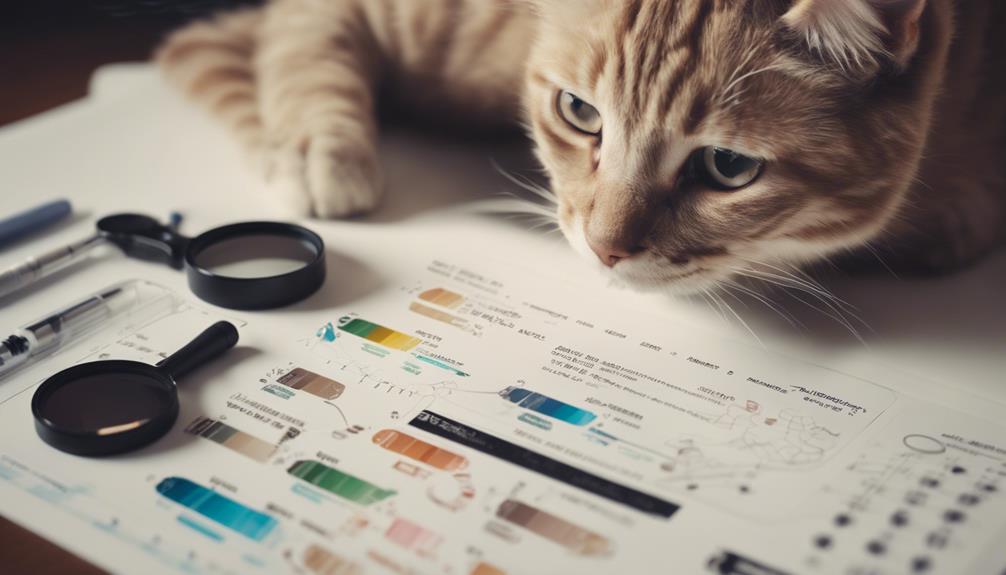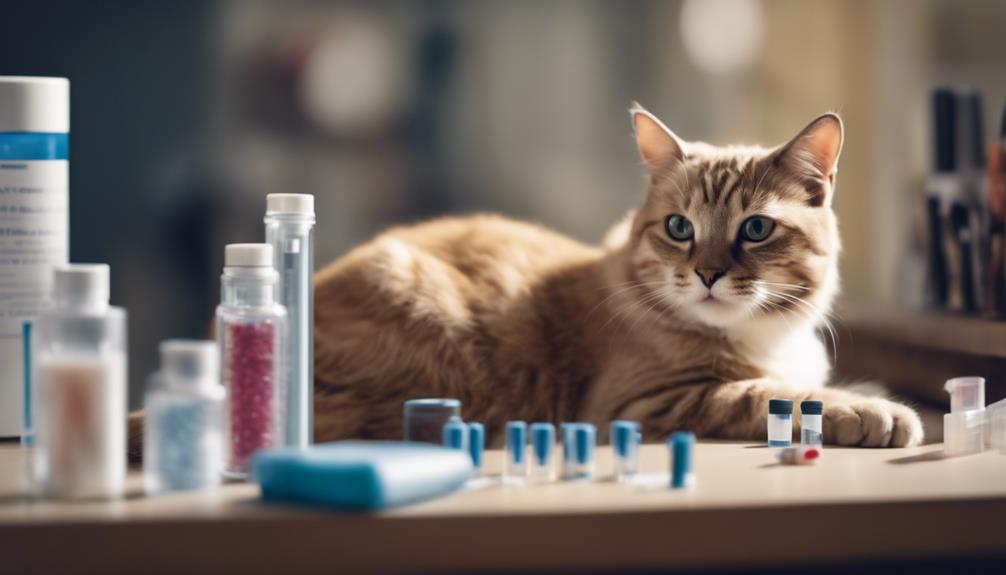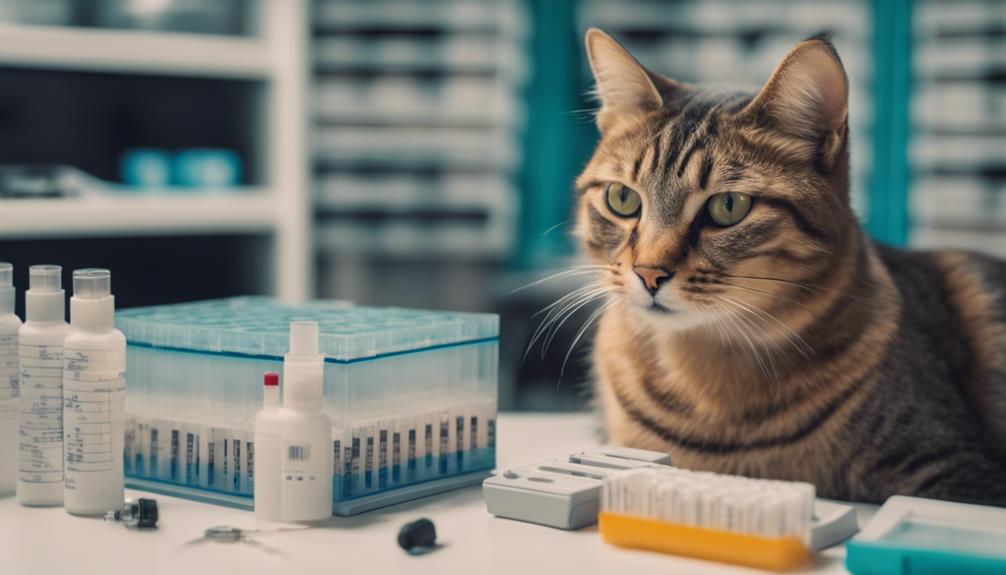Within the intricate tapestry of feline genetics, the mystery of your cat's breed holds a key to unlocking a wealth of knowledge crucial to their care. The advent of DNA testing has revolutionized our understanding of cats, offering insights into their heritage, health predispositions, and unique traits.
By uncovering the secrets encoded in their genes, a cat's DNA profile not only reveals their lineage but also provides a roadmap for tailored healthcare strategies. As the veil of uncertainty surrounding your cat's breed is lifted through DNA testing, a new world of possibilities emerges, waiting to be explored.
Key Takeaways
- Cat DNA testing reveals breed profile mysteries, providing insights into ancestry and unique traits.
- Identification of genetic markers for diseases like PKD1, HCM, GM2, and rdAc enables personalized care.
- Uncover unexpected mixed-breed combinations, explaining behaviors and health clues for proactive measures.
- Enhance the bond with your cat by understanding their genetic blueprint, promoting tailored healthcare for their well-being.
Benefits of Cat DNA Testing
Understanding the benefits of cat DNA testing can provide valuable insights into a feline's breed profile, predisposition to diseases, physical traits, wildcat index, and overall health status. By unraveling a cat's genetic blueprint, owners can gain a deeper understanding of their pet's unique characteristics and potential health risks. This knowledge empowers caregivers to make informed decisions about their cat's well-being, from choosing appropriate diets to implementing preemptive healthcare measures.
Furthermore, uncovering a cat's wildcat index can shed light on its ancestry and behavior traits, enhancing the bond between pet and owner. Ultimately, cat DNA testing offers a window into a cat's genetic heritage, equipping owners with essential information to ensure their beloved feline companion leads a healthy and fulfilling life.
Process of Cat DNA Testing
Unraveling the genetic blueprint of a cat through DNA testing involves a meticulous process that begins with swabbing for saliva and culminates in a detailed analysis of over 20,000 genes. This intricate journey of discovery provides cat owners with valuable insights into their feline companions.
The process includes:
- Swabbing for Saliva: A simple and non-invasive method to collect the DNA sample.
- Sending Sample to Basepaws: A renowned facility in Los Angeles specializing in cat DNA analysis.
- Analyzing Over 20,000 Genes****: The key step in unlocking the secrets of a cat's breed makeup and genetic health markers.
Options for Cat DNA Testing

When considering cat DNA testing, owners have various options available to suit their needs and budget. One option is the standard DNA and health test, which provides valuable insights into the cat's breed makeup and potential health concerns.
For those seeking more comprehensive information, there is a more expensive test that sequences the entire genome, offering detailed lifetime health and breed updates. These tests are conveniently available on platforms like Amazon, making them easily accessible to cat owners.
Not only do these tests help in determining the dominant breeds in mixed-breed cats, but they also shed light on any genetic predispositions to diseases, allowing for proactive healthcare measures.
Importance of Cat DNA Testing
Considering the myriad health and genetic benefits that cat DNA testing can offer, it becomes evident that this diagnostic tool plays a crucial role in proactive feline healthcare.
- Early Detection: Cat DNA testing can help reveal potential health problems before they manifest clinically, allowing for early intervention and treatment.
- Tailored Care: Understanding a cat's genetic predispositions through DNA testing enables personalized healthcare plans that cater to their specific needs.
- Breed-Specific Insights: By uncovering a cat's breed profile and genetic makeup, DNA testing provides valuable insights into their behavior, traits, and potential health risks.
These factors highlight the significance of incorporating DNA testing into the overall healthcare strategy for cats, ensuring a holistic approach to their well-being.
Considerations for Cat DNA Testing

Factors to ponder before opting for cat DNA testing include the unpredictability of test results and the significance of regular veterinary examinations. Purebred cats are easier to determine breeds, while shelter cats have unknown breed backgrounds. Interestingly, kittens in the same litter can have different fathers, adding to the complexity of DNA testing outcomes. Emphasizing the importance of regular vet check-ups is crucial, as DNA test results may not always provide a complete health picture. Combining the insights from DNA testing with routine vet visits can offer a comprehensive approach to feline healthcare.
| Considerations | Details | Importance |
|---|---|---|
| Breed predictability | Purebreds vs. shelter cats | Understanding origins |
| Sibling variations | Kittens from same litter | Genetic surprises |
| Vet collaboration | Regular check-ups | Holistic care |
Revealing Breed Profiles
Revealing the breed profiles of cats through DNA testing provides valuable insights into their genetic heritage and characteristics.
- Understanding Ancestral Roots: DNA testing can uncover the different breeds that make up a cat's genetic background, shedding light on their lineage and origins.
- Identifying Unique Traits: By revealing breed profiles, owners can better understand the specific physical and behavioral traits associated with their cat's genetic makeup.
- Building a Stronger Bond: Knowing the breed profile of a cat can lead to a deeper connection between owners and their feline companions, enhancing the overall relationship and care provided.
Detecting Disease Markers

Detection of disease markers through cat DNA testing is crucial for proactive health management and early intervention. By identifying genetic predispositions to certain diseases, pet owners can take preventative measures and monitor their cat's health more effectively. Below is a table illustrating some common genetic disease markers that can be detected through cat DNA testing:
| Disease Marker | Associated Conditions |
|---|---|
| PKD1 Mutation | Polycystic Kidney Disease |
| HCM Genetic Variant | Hypertrophic Cardiomyopathy |
| GM2 Mutation | Gangliosidosis |
| rdAc Mutation | Retinal Degeneration |
Understanding these markers can help cat owners work closely with veterinarians to develop personalized care plans and ensure the well-being of their feline companions.
Understanding Mixed-Breed Cats
Understanding the diverse genetic backgrounds of mixed-breed cats can provide valuable insights into their unique traits and characteristics.
- Mystery Unraveled: Uncovering the genetic makeup can reveal unexpected breed combinations that contribute to a cat's appearance and behavior.
- Health Clues: Knowing the genetic predispositions in mixed-breed cats can assist in proactive healthcare measures and early detection of potential health issues.
- Personality Puzzle: Genetic insights can help explain a cat's temperament, preferences, and behaviors, shedding light on their individuality.
Conclusion
In the intricate tapestry of feline care, cat DNA testing serves as a beacon of light, unraveling the mysteries of breed origins and health predispositions. Like a skilled artist, this technology paints a vivid portrait of a cat's genetic makeup, revealing hidden patterns and colors that shape their well-being.
By embracing the power of DNA testing, we can navigate the labyrinth of our feline companions' genetic code and pave the way for tailored care and understanding.




